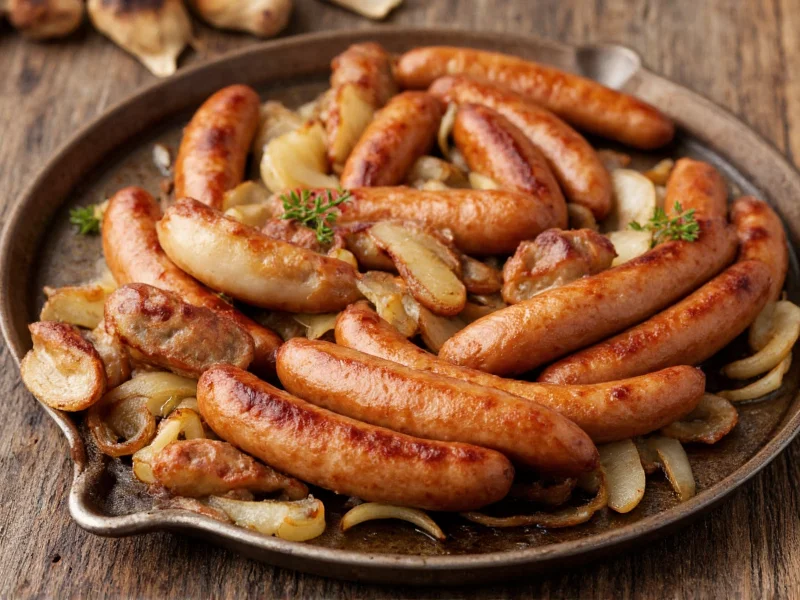The Perfect Harmony of Sausage and Onions
When you combine sausage and onions, you're creating a culinary partnership that has stood the test of time. The natural sugars in onions caramelize beautifully when cooked, creating complex flavor compounds that complement the savory, fatty nature of quality sausage. This pairing appears in traditional dishes from German bratwurst mit zwiebeln to Italian sausage and peppers (which often includes onions), and American breakfast favorites.
Why This Flavor Combination Works So Well
The science behind this successful pairing lies in basic flavor chemistry. Sausage typically contains high levels of umami compounds from the meat and seasonings, while onions provide natural sweetness that develops further when cooked. When onions are properly caramelized, they undergo the Maillard reaction and caramelization, creating hundreds of new flavor compounds that bridge the gap between the rich sausage and other potential accompaniments.
Professional chefs recognize that the sulfur compounds in onions actually help break down some of the heavier fat molecules in sausage, making the overall dish feel less greasy and more balanced on the palate. This is why you'll rarely find sausage recipes that don't incorporate some form of allium (onions, garlic, leeks).
Best Sausage Varieties for Cooking with Onions
Not all sausages work equally well with onions. Here's a breakdown of the most compatible pairings:
| Sausage Type | Best Onion Preparation | Recommended Cooking Method |
|---|---|---|
| Bratwurst | Thinly sliced yellow onions, lightly caramelized | Par-cook in beer, then finish in onion mixture |
| Italian Sausage | Onions cooked down until soft with bell peppers | Sear sausage first, then cook vegetables in rendered fat |
| Breakfast Sausage | Onions cooked until golden brown | Simmer together in cast iron skillet |
| Chorizo | Red onions for color contrast, quick sauté | Grill sausage, quick pan-fry for onions |
Mastering the Cooking Process: Step-by-Step
While seemingly simple, cooking sausage and onions properly requires attention to timing and technique. Follow these steps for perfect results every time:
- Choose quality ingredients - Select fresh, high-quality sausage with visible meat content (avoid products where "mechanically separated meat" appears on the label) and firm, dry onions without soft spots
- Prep properly - Slice onions uniformly (about 1/4 inch thick) to ensure even cooking. For sausage, prick casings gently with a fork if cooking whole
- Manage heat carefully - Start with medium heat to render sausage fat gradually without burning. Never use high heat initially
- Timing is crucial - Cook onions first until translucent (about 5 minutes), remove, then cook sausage. Return onions during the last 5-7 minutes of sausage cooking
- Season thoughtfully - Add salt to onions early to draw out moisture, but wait until the end to add additional salt to sausage which already contains sodium
- Finish with acidity - A splash of vinegar, wine, or lemon juice at the end brightens the rich flavors
Avoiding Common Mistakes
Many home cooks make these critical errors when preparing sausage and onions:
- Overcrowding the pan - This steams rather than sears your ingredients. Use a large skillet and work in batches if necessary
- Adding salted onions to already salty sausage - Many sausages contain significant sodium, so be cautious with additional salt
- Rushing the caramelization process - Properly caramelized onions take 20-30 minutes of patient cooking over medium-low heat
- Cooking everything together from the start - Sausage and onions have different ideal cooking times and temperatures
- Using sweet onions exclusively - While Vidalia or Walla Walla onions are delicious, mixing with yellow onions provides better flavor complexity
Serving Suggestions and Culinary Applications
Sausage and onions serve as a versatile base for numerous dishes. Consider these serving options:
- Classic German-style with sauerkraut and mustard on the side
- As a pizza topping with mozzarella and fresh herbs
- Stuffed into bell peppers or portobello mushrooms
- Over creamy polenta or mashed potatoes for a hearty meal
- In breakfast burritos with scrambled eggs and cheese
- As a sandwich filling on crusty rolls with horseradish mayo
For an elevated presentation, try layering the sausage and onions with apple slices for a sweet-savory contrast, or add a splash of bourbon during the final cooking stage for depth of flavor. The addition of fresh herbs like thyme or rosemary during cooking can transform this simple combination into something restaurant-worthy.
Storage and Reheating Guidelines
Properly stored, cooked sausage and onions will maintain quality for 3-4 days in the refrigerator. Place in an airtight container after cooling to room temperature (within 2 hours of cooking). For longer storage, freeze in portion-sized containers for up to 3 months.
When reheating, avoid the microwave if possible as it can make sausage rubbery. Instead, gently warm in a skillet over medium-low heat with a small amount of liquid (water, broth, or apple juice) to prevent drying. If using a microwave, cover the dish and use 50% power in 1-minute intervals, stirring between each interval.











 浙公网安备
33010002000092号
浙公网安备
33010002000092号 浙B2-20120091-4
浙B2-20120091-4